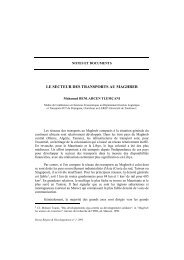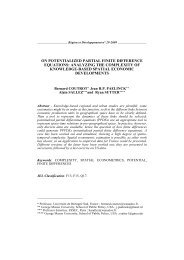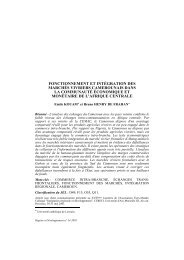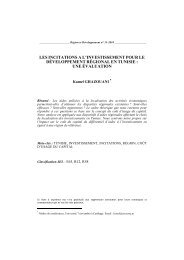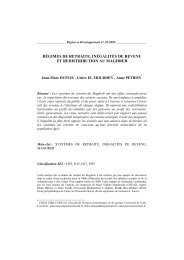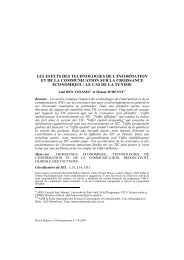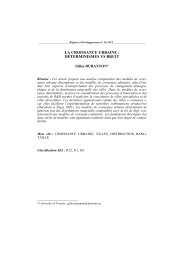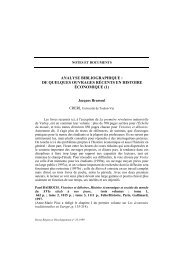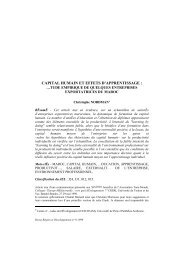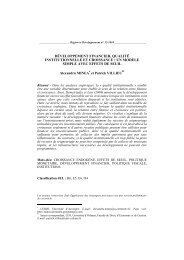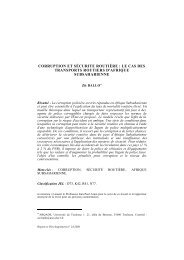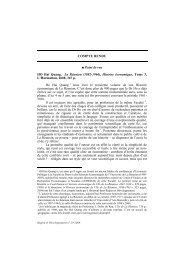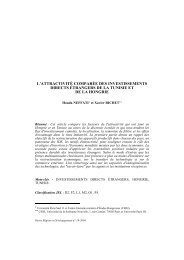space and growth: a survey of empirical evidence ... - ResearchGate
space and growth: a survey of empirical evidence ... - ResearchGate
space and growth: a survey of empirical evidence ... - ResearchGate
Create successful ePaper yourself
Turn your PDF publications into a flip-book with our unique Google optimized e-Paper software.
34 Maria Abreu, Henri L.F. de Groot <strong>and</strong> Raymond J.G.M. FloraxAnother solution regarding the problem <strong>of</strong> disentangling individual <strong>and</strong>contextual effects would be to use a hierarchical or multilevel model. This is aninteresting possibility that has been explored using spatial econometrics,although not in connection with <strong>growth</strong>.The modifiable areal unit problem occurs when there are several ways <strong>of</strong>drawing up boundaries for the objects under consideration. For example,regional data can <strong>of</strong>ten be aggregated in several ways (e.g., according to political,administrative, cultural, or labor market boundaries). The problem is thatthe variation in a variable <strong>of</strong> interest can be lost when changing the level <strong>of</strong>aggregation, or the boundaries <strong>of</strong> the data set. The level <strong>of</strong> aggregation should bechosen according to the theoretical model under consideration. For instance,since macroeconomic policy is made at the national level, studies <strong>of</strong> policy <strong>and</strong><strong>growth</strong> should focus on cross-country data. Technology diffusion, on the otherh<strong>and</strong>, may occur primarily within specific sectors <strong>of</strong> the economy (Keller, 2002),while EU agricultural funds are provided to regions (Ramajo et al., 2003). Theseconsiderations should be taken into account when constructing the model <strong>and</strong>defining the scope for the analysis.3.3.2. Choice <strong>of</strong> scale <strong>and</strong> scope <strong>of</strong> the analysisA related problem is the disparity in the size <strong>of</strong> spatial units that comprisethe dataset used in the analysis. For example, in cross-country studies a smallcountry like Jamaica has the same weight as China, one <strong>of</strong> the largest. Similarlythe states <strong>of</strong> the US are equivalent in size <strong>and</strong> economic output to some middlesizedcountries, <strong>and</strong> the European NUTS classification system sometimesincludes regions <strong>of</strong> different sizes together in the same category. The problem isthe disaggregated nature <strong>of</strong> the data collection system, which is <strong>of</strong>ten done at thenational level using political <strong>and</strong> administrative boundaries that differ in sizeacross countries. Aggregating several smaller units into larger ones <strong>of</strong>ten makesmatters worse, since it averages out the variation in the variables <strong>of</strong> interest (themodifiable areal unit problem discussed above). One solution may be to redefinethe boundaries <strong>of</strong> the spatial units from scratch, using highly disaggregated data<strong>and</strong> Geographical Information Systems (see, for example, Cheshire et al., 1995,Masters <strong>and</strong> McMillan, 2001 <strong>and</strong> Kosfeld <strong>and</strong> Lauridsen, 2004).Another aggregation problem occurs when the spillovers <strong>of</strong> interest are ata lower level <strong>of</strong> aggregation than is typically considered; for instance,technology spillovers are likely to occur across countries but within the samesector. This issue has not been explored in spatial econometrics, <strong>and</strong> it would beinteresting to see an application using for example multilevel models.




